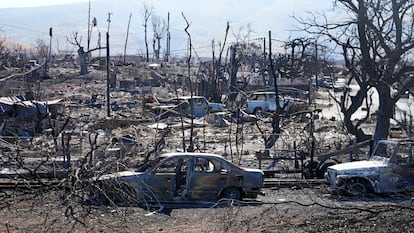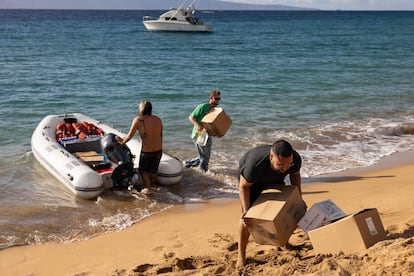Maui fire is now the deadliest the US has seen in more than a century
Only two of the 93 confirmed victims have been identified, while a thousand people remain missing. Authorities have come under attack for not doing more to warn residents of the danger

The death toll from the devastating Maui wildfires rose to 93 on Saturday, making it the deadliest fire in the United States in more than a century. Authorities warn the toll is set to rise further as rescue teams search the charred remains of buildings. Only 3% of the affected area has been searched, according to Hawaii Governor Josh Green, and 12 more dogs have been brought in to assist with the effort. More than a thousand people are still missing. “This is the largest natural disaster we’ve ever experienced,” Green said. “It’s going to take an incredible amount of time to recover from.”
Only two of the 93 confirmed victims have been identified so far, according to authorities in Maui County, the epicenter of the disaster. John Pelletier, the local police chief, warned that the process will take time, since DNA testing and dental record comparison is needed due to the charred state of the corpses. The ferocity of the flames melted metal and destroyed more than 80% of Lahaina, the ancient capital of the Hawaiian kingdom, where rescuers believed more bodies will be found.

The Maui wildfire is the deadliest since 1918, when 453 people died in Minnesota and Wisconsin, said the National Fire Protection Association (NFPA). The damage is estimated to be close to $6 billion, with some 2,200 homes destroyed in West Maui and 2,170 hectares devastated by the flames. Local authorities estimate that more than 14,000 people were evacuated from the island during on Wednesday, while about 14,500 were transferred to other nearby islands throughout Friday. Six temporary shelters on Maui have been set up, while the flight of tourists has allowed authorities to requisition a thousand hotel rooms, half for residents and half for rescue workers. Volunteer psychologists are helping victims in makeshift stands around the city.
The cause of the terrible wildfires is being investigated, but experts say that its rapid spread was helped by factors such as the abundance of non-native plants, the volcanic topography, which favored the flow of dry winds down the slope, an unusually arid winter and the tailspins of hurricane Dora, a hundred miles to the southwest.
It is difficult to appreciate the scale of the disaster given that Hawaii is a state not unused to natural catastrophes — earthquakes, active volcanoes, tsunamis and periodic tropical storms. The lack of warning is considered by many of those affected to be the main cause of the high death toll. In the U.S., if there is an emergency, an alert is typically sent out to cell phones. But residents received no such message, meaning they were not aware of the danger and did not flee. Many locals say that they were only aware of the danger when they saw the fire outside their home. “The mountain behind us caught on fire and nobody told us jack,” Vilma Reed, a 63-year-old resident, told AFP. With his daughter, grandchildren and cats in the car, she attempted a desperate escape. “I raced a line of fire to get my family out,” she said.

“We underestimated the lethality, the quickness of fire,” Hawaii congresswoman Jill Tokuda told CNN on Saturday. “It’s not like hurricane force winds are unknown to Hawaii, or dry brush, or red flag conditions. We saw this before in [Hurricane] Lane. We did not learn our lesson from Lane [in 2018] — that brush fires could erupt as a result of churning hurricane winds below us to the south,” Tokuda said.
The technical failures and the lack of warnings from authorities have angered the victims. The fire knocked out power and residents say they had no cell service. But the more robust outdoor warning sirens did not sound either, the Hawaii Emergency Services Administration (HI-EMA) said Friday. “Neither Maui nor HI-EMA activated warning sirens on Maui during the wildfire incident,” the organization said, according to NBC News.
Like the process of identifying the victims, determining the reasons for the disaster will take time. When asked if more could have been done to warn residents, Gov. Green pointed out that the state Attorney General’s office has launched an investigation into the response to the fires, and called for caution.
“The largest force at play that night were 80 mile-per-hour winds. That created an incredibly intense and dangerous circumstance,” Green said. “Having seen that storm, we have doubts that much could have been done with a fast-moving fire like that.”
Sign up for our weekly newsletter to get more English-language news coverage from EL PAÍS USA Edition
Tu suscripción se está usando en otro dispositivo
¿Quieres añadir otro usuario a tu suscripción?
Si continúas leyendo en este dispositivo, no se podrá leer en el otro.
FlechaTu suscripción se está usando en otro dispositivo y solo puedes acceder a EL PAÍS desde un dispositivo a la vez.
Si quieres compartir tu cuenta, cambia tu suscripción a la modalidad Premium, así podrás añadir otro usuario. Cada uno accederá con su propia cuenta de email, lo que os permitirá personalizar vuestra experiencia en EL PAÍS.
¿Tienes una suscripción de empresa? Accede aquí para contratar más cuentas.
En el caso de no saber quién está usando tu cuenta, te recomendamos cambiar tu contraseña aquí.
Si decides continuar compartiendo tu cuenta, este mensaje se mostrará en tu dispositivo y en el de la otra persona que está usando tu cuenta de forma indefinida, afectando a tu experiencia de lectura. Puedes consultar aquí los términos y condiciones de la suscripción digital.
More information
Archived In
Últimas noticias
There is as much life left to discover on planet Earth as that which is already known
Dozens presumed dead, around 100 injured in fire at Swiss Alps bar during New Year’s celebration
Is porn for women different from conventional porn? We spoke to those who make it
Cartagena de Indias is sinking: What can the city do to mitigate it?
Most viewed
- Reinhard Genzel, Nobel laureate in physics: ‘One-minute videos will never give you the truth’
- David King, chemist: ‘There are scientists studying how to cool the planet; nobody should stop these experiments from happening’
- Sinaloa Cartel war is taking its toll on Los Chapitos
- Oona Chaplin: ‘I told James Cameron that I was living in a treehouse and starting a permaculture project with a friend’
- The Interoceanic Train, the Mexican alternative to the Panama Canal










































